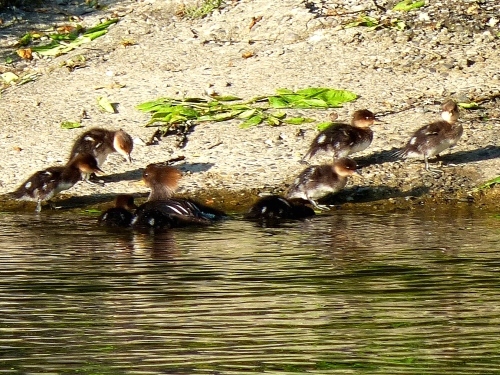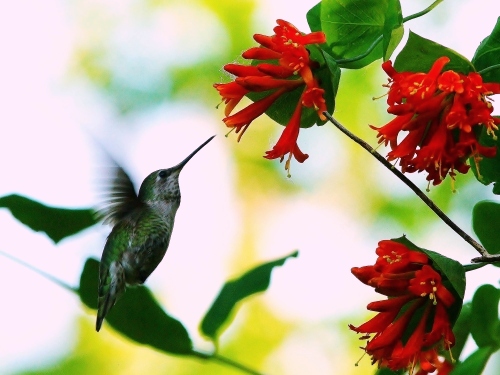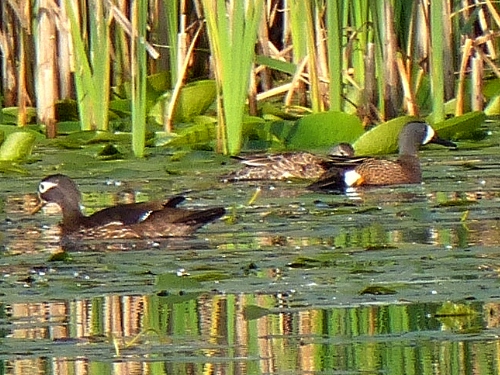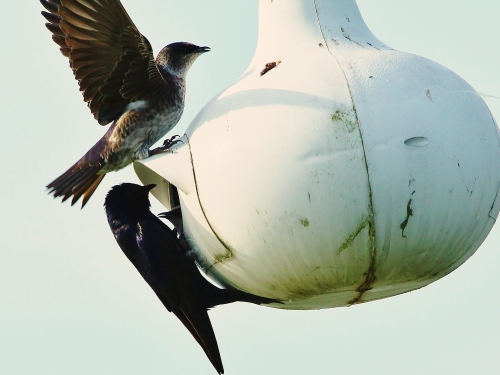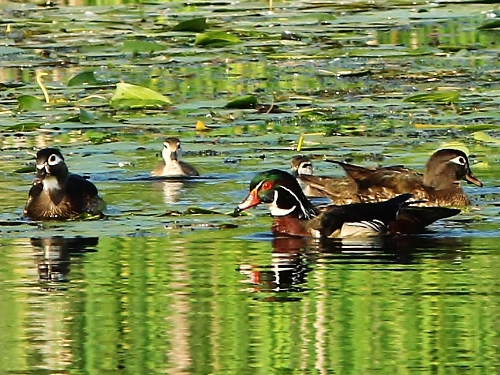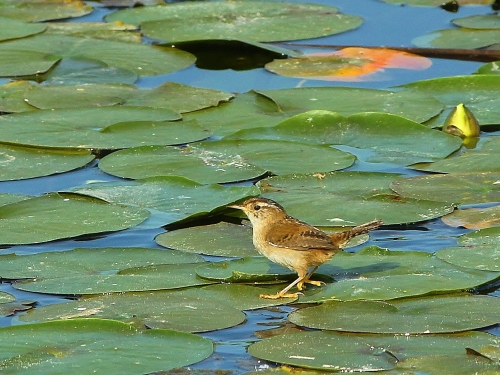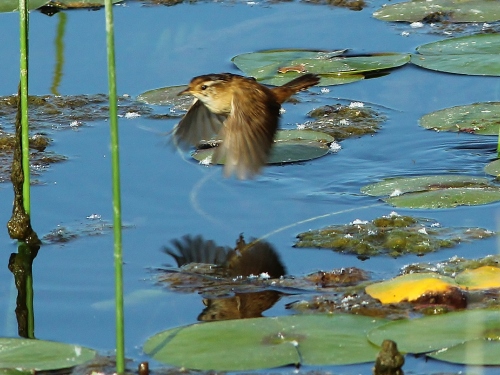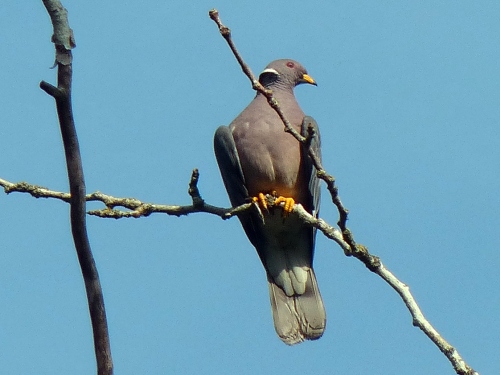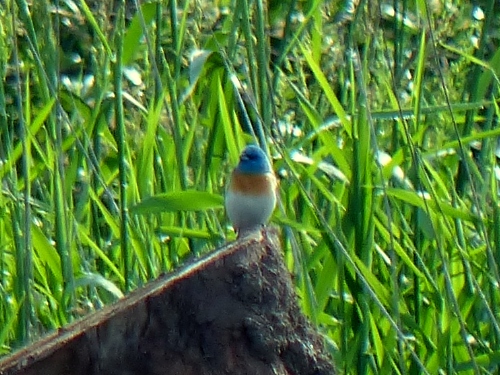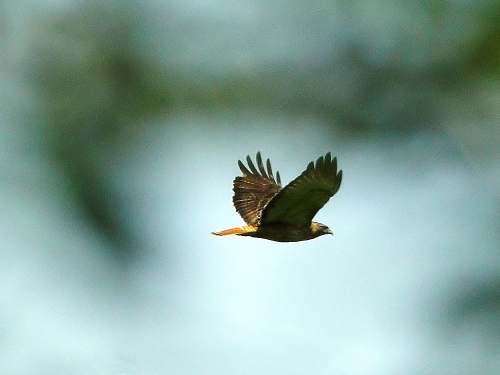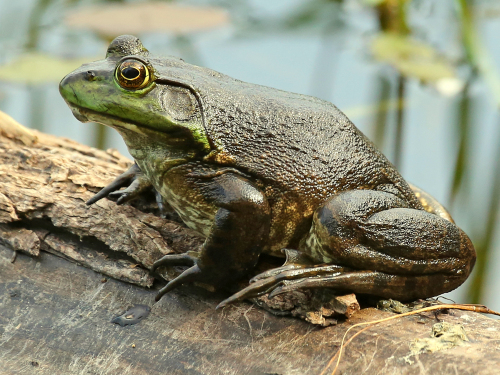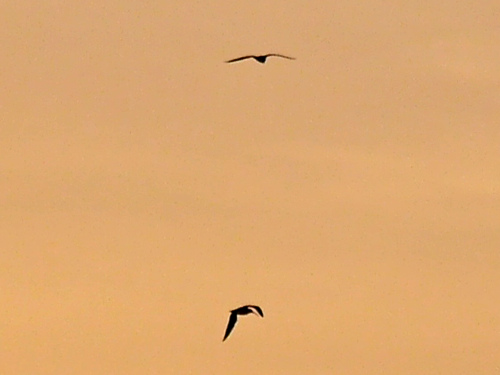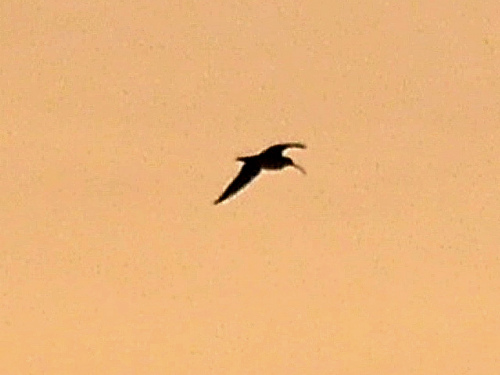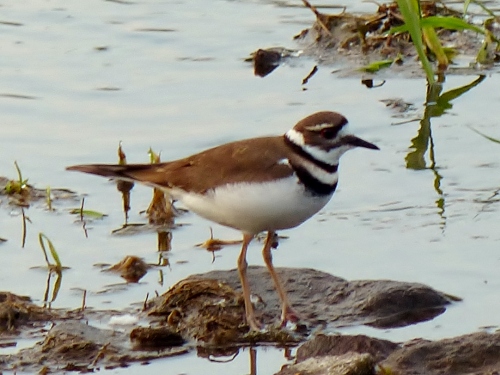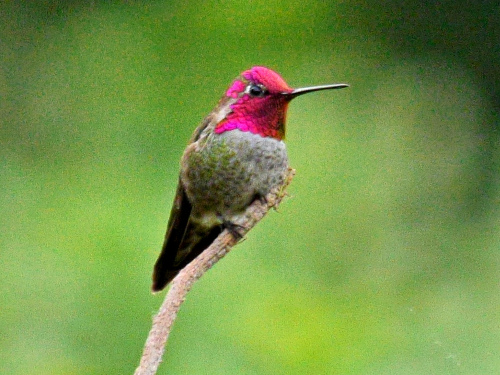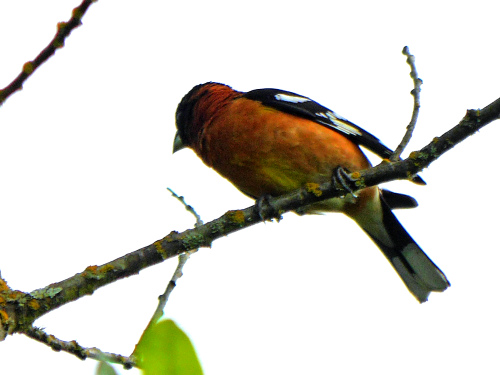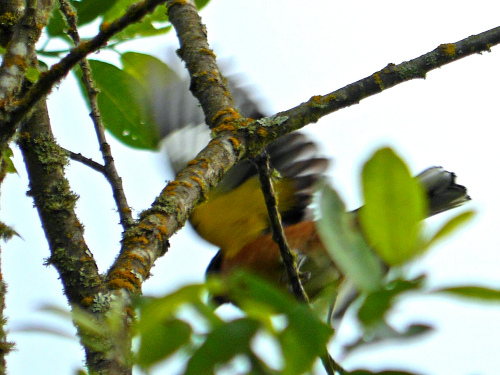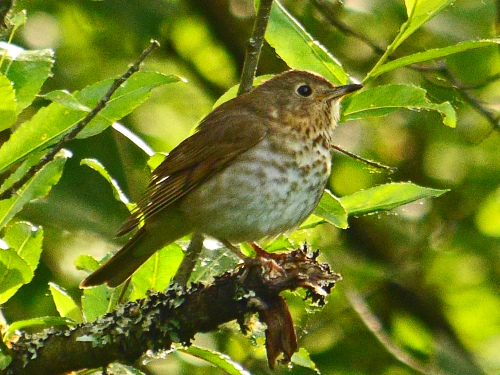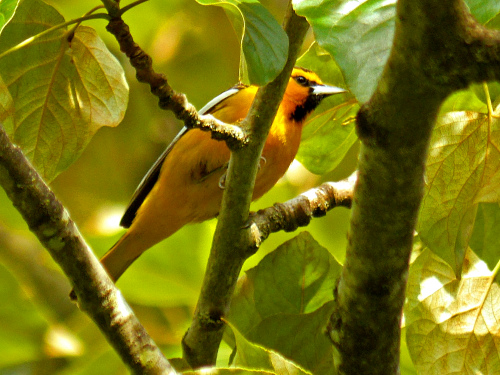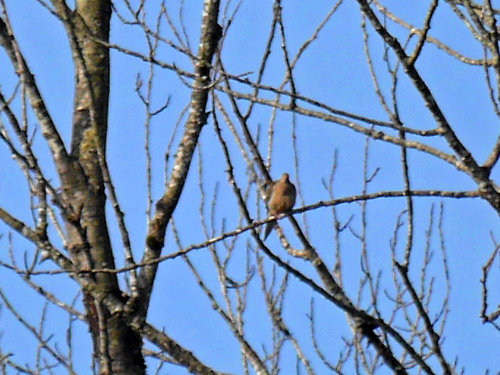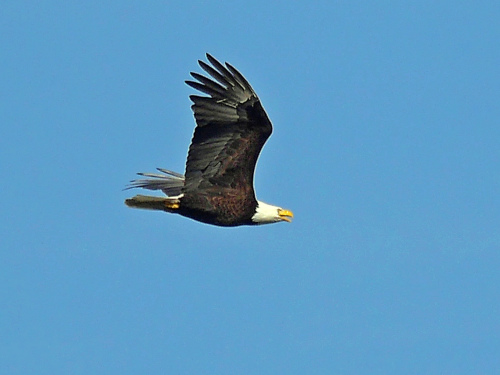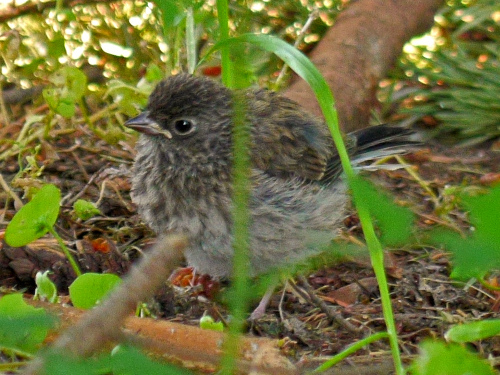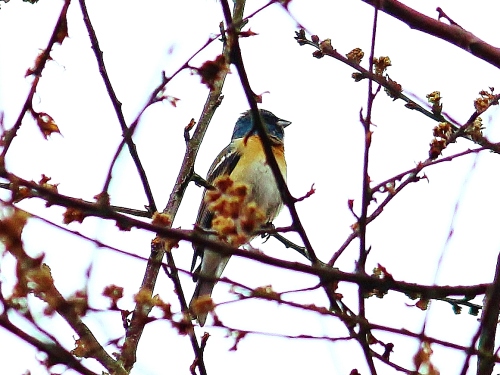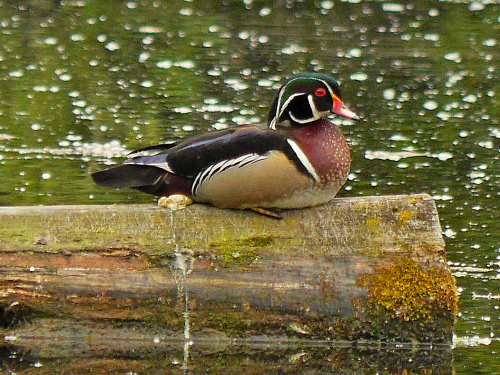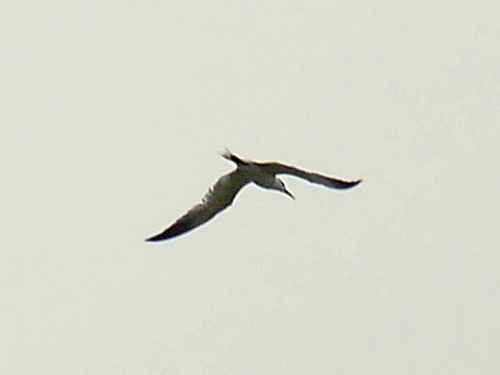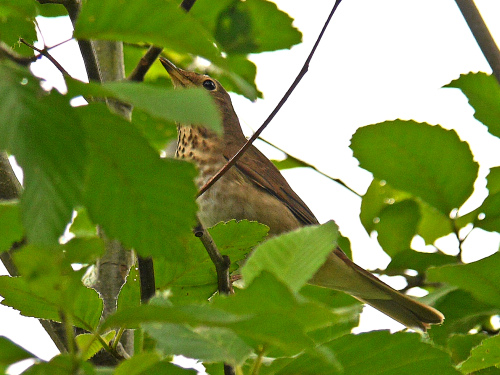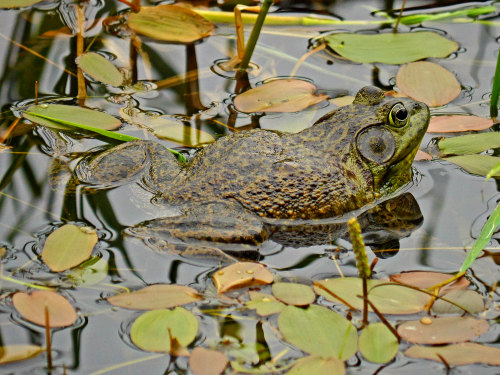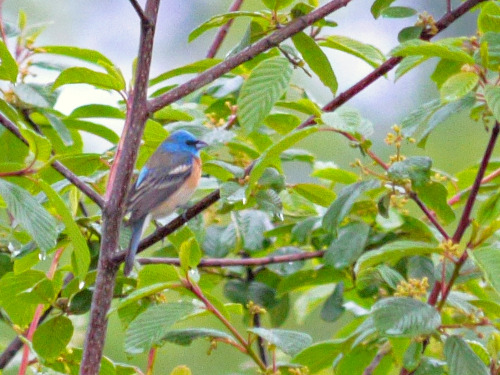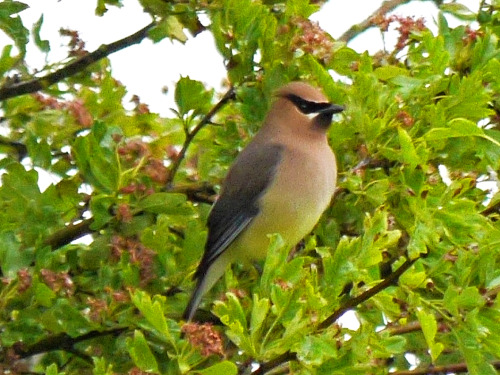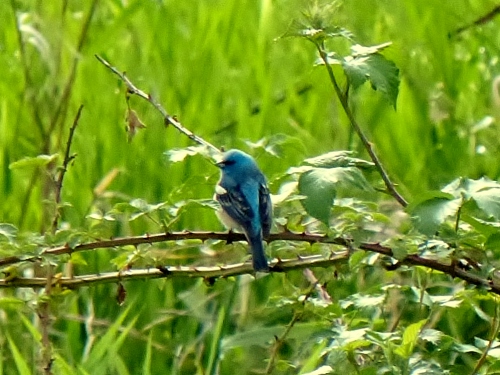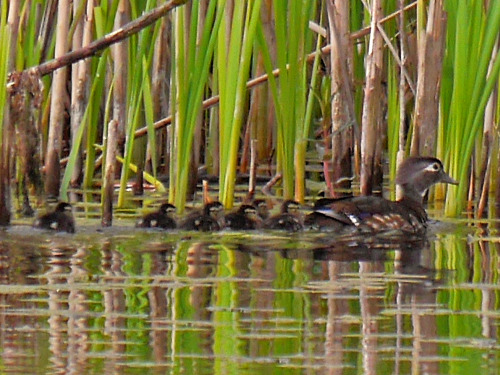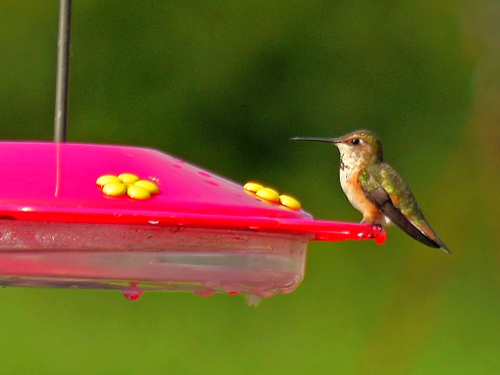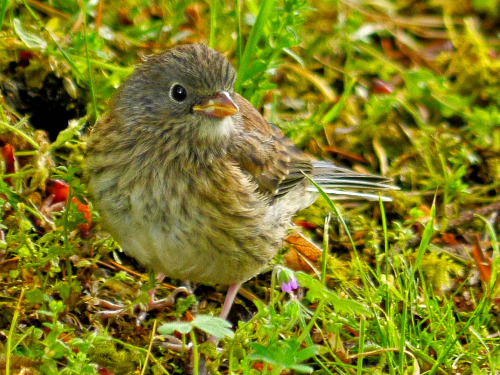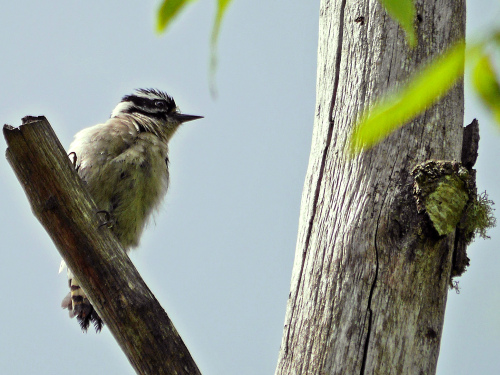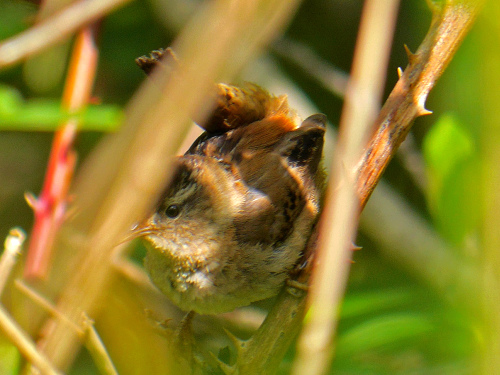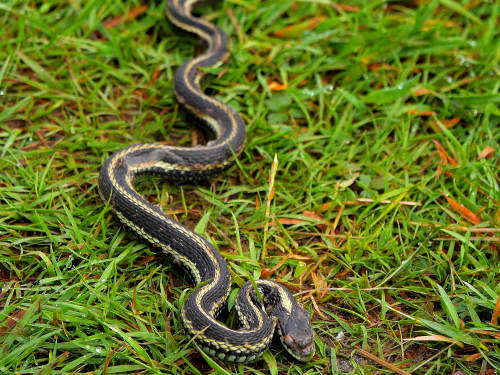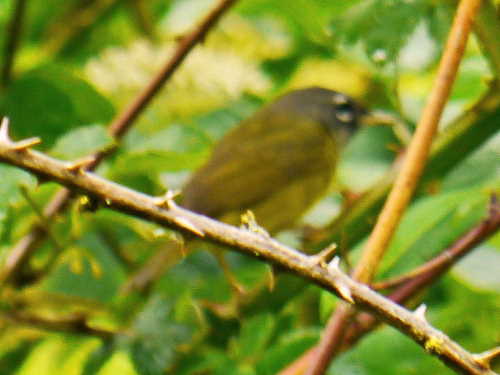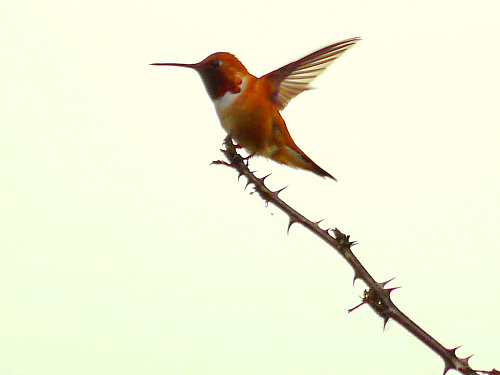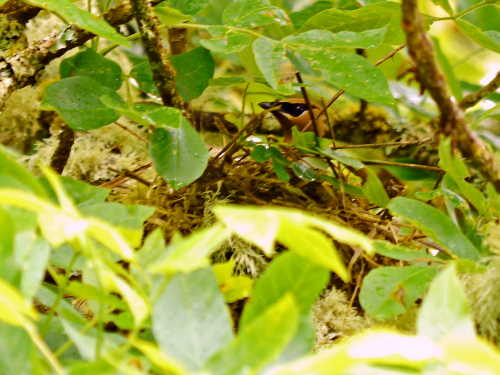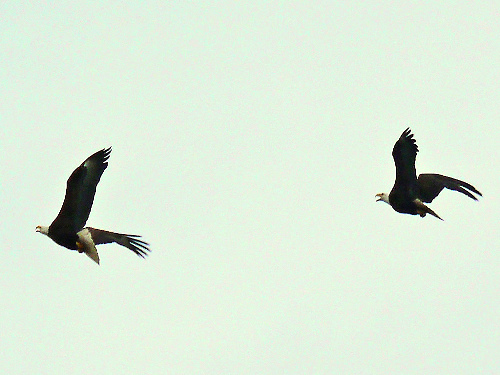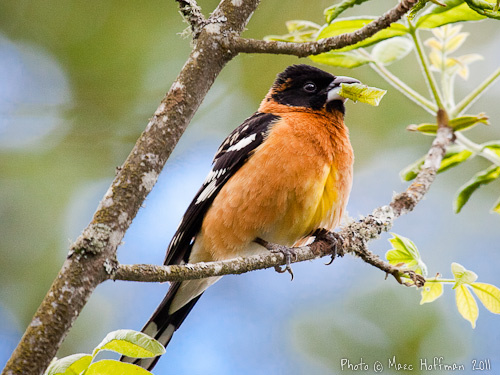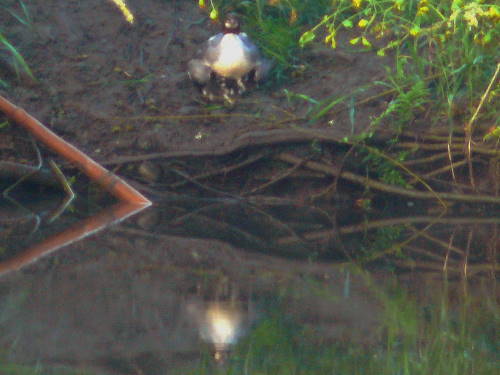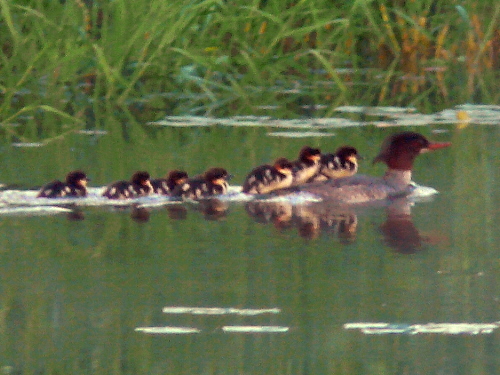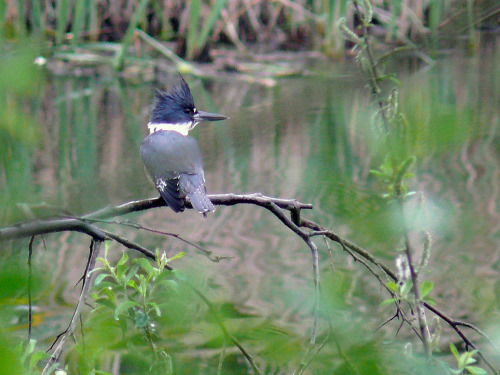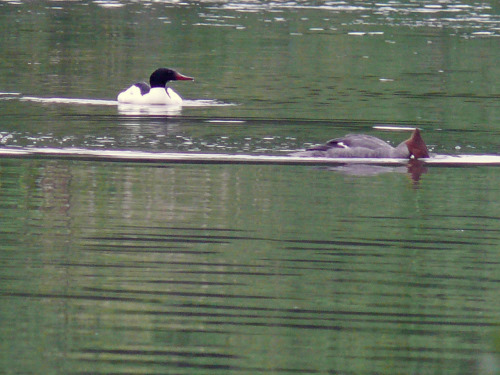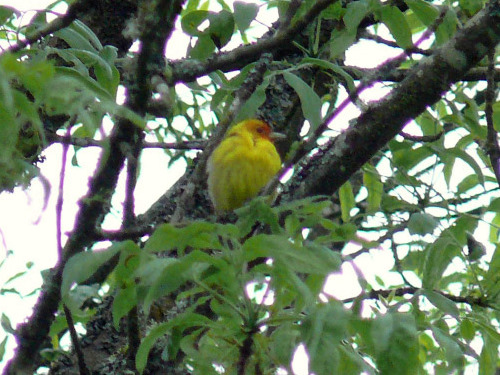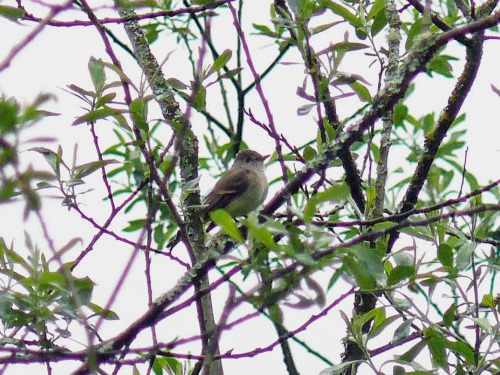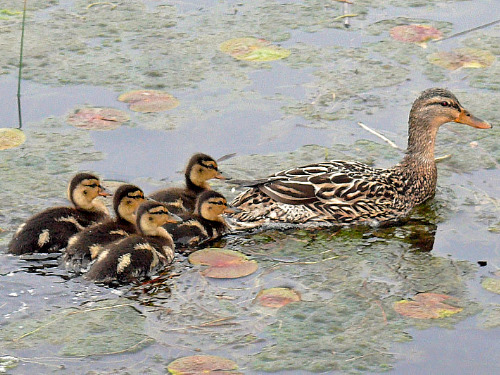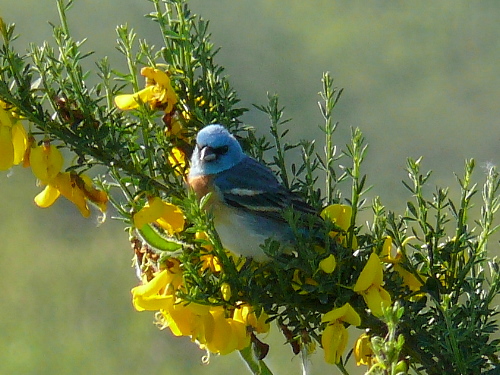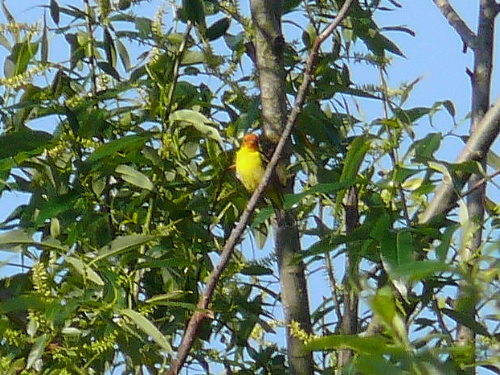Prev |
Bird Sightings Week 21
|
Next |
Rarities for Week 21:
| Redhead | 23-May-95 | Two birds |
| Whimbrel | 22-May-14 | Two birds |
| Long-billed Dowitcher | 27-May-21 | |
| Pectoral Sandpiper | 26-May-17 | eBird photo Rick Tyler and others, 27-May-17 eBird photo Chuck Jensen |
| Common Tern | 24-May-15 | eBird report from Matthew Pike |
| Lapland Longspur | 24-May-16 | |
| Vesper Sparrow | 21-May-03 | Reported by Bruce Jones |
Report for May 22, 2025 Birding at Marymoor
| The day began slowly under a high overcast, but as the day warmed and the skies cleared, the birds came out. The Rowing Club had a burst of birds. Highlights:
For the day, 64 species plus the mystery gulls. For the year, we're up to 114. = Michael Hobbs |
Report for May 23, 2024 Birding at Marymoor
| Unlike last week’s walk, we stayed dry today - not particularly sunny, but dry - the birds were much more cooperative than last week, and we enjoyed a pleasant day at Marymoor. With Michael still away, 6 of us combined forces to take on the walk today. We came up with 62 species for the day. Highlights:
Misses for the day: Spotted Sandpiper, Green Heron, Virginia Rail, Pileated Woodpecker, Bullock’s Oriole [might have heard a little chattering] and Yellow-rumped Warbler. Matt Bartels |
Report for May 25, 2023 Birding at Marymoor
| A gorgeous day at Marymoor this morning. There was a little bit of ground fog that lasted for the first 45 minutes of the walk, but other than that the weather was perfect. Sunny, never too hot. 49-65 degrees. There was quite a bit of bird activity, but species diversity is extremely low. We had just 55 species today. That's six fewer species than the lowest total in the preceding 10 years, and is 10+ species below the preceding 10-year average! Still, there were some things to see. Highlights:
There are also 5-10 species that have usually (at least 12 of the last 20 years) been seen at Marymoor which have not been reported this year. And there's another 5+ that have been reported on eBird, but have not been seen on our surveys this year. Also, swallow and swift numbers seem very, very low. Kind of worrying. As I said, for the day just 55 species. = Michael Hobbs |
|
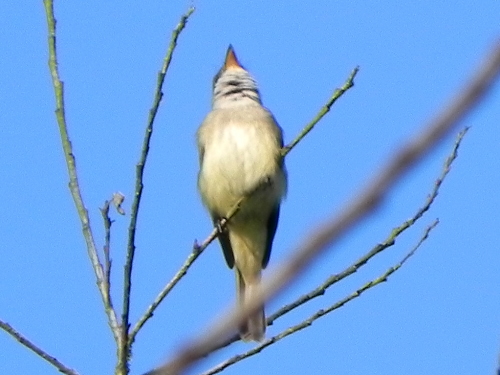 Willow Flycatcher. Hear it sing "Fitz Bew". Photo by Michael Hobbs |
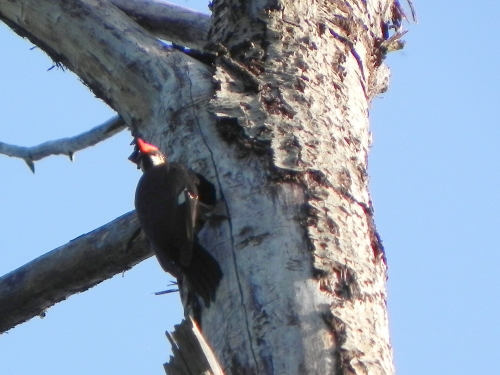 Pileated Woodpecker bringing food to young in the nest. Photo by Michael Hobbs |
Report for May 26, 2022 Birding at Marymoor
|
We had high overcast and a very few sprinkles late in the morning, but otherwise the weather was really good. Steve Hampton posted to Tweeters this morning that the radar had shown a lot of bird migration last night. Unfortunately, at least at Marymoor, it appears to have been the departure of many, many birds. Our species count was way down from last week, and numbers for some of the remaining birds were also way down.
Highlights:
At the Rowing Club, PILEATED WOODPECKER(s) were doing their “long call” non-stop for minutes. We finally found one of them, quite agitated on a telephone poll, glaring at something. Following its gaze, I spotted what I thought at first was a house cat, but then the cat jumped over the fence and I got a great look at a BOBCAT. This would have been just SE of the parking lot under the trees. Despite following the mixed flock of agitated birds, we were unable to get another look a the kitty.
While we did get actual looks at some species that are often hard to see (MARSH WREN, SWAINSON’S THRUSH, COMMON YELLOWTHROAT), the big story today was the long list of birds we didn’t find today at Marymoor. We had none of the non-breeding species that were so numerous last week (no Black-swift, Short-billed Gull, Caspian Tern, Pacific-slope Flycatcher, Cassin’s Vireo, Northern Rough-winged Swallow, Evening Grosbeak, Golden-crowned Sparrow, Western Meadowlark, Nashville Warbler, MacGillivray’s Warbler, or Yellow-rumped Warbler). These may all be heading to breeding locations away from the park.
Statistical misses (those seen 50% or more previous years, but not today) included Rock Pigeon, Vaux’s Swift, Spotted Sandpiper, Green Heron, Belted Kingfisher, Barn Swallow, Cliff Swallow, Bushtit, Golden-crowned Kinglet, and Yellow-rumped Warbler.
For the day, just 61 species (down from 77 last week!)
= Michael Hobbs
|
Report for May 27, 2021 Birding at Marymoor
|
We had a wet one today, with drizzle and rain for most of the morning. There was a bit of a let-up, and even some blue sky, after we finished the main loop. The dark overcast and rain meant there was little to look at for much of the walk. We could hear some birds, and indeed we had 7 species that were heard-only. Another couple of species were actually seen only by one or two of us, and there would have been at least 3 more heard-only species except for some looks at the Rowing Club. That said, it wasn’t a bad day.
Highlights:
Misses today included Rock Pigeon, Green Heron, Downy Woodpecker, Steller’s Jay, and Western Tanager.
For the day, 66 species. Adding four to the year list, we’re now at 141 for 2021.
= Michael Hobbs
|
Report for May 26, 2020 Birding at Marymoor
|
With the weather a little better than last Thursday, I decided to do another walk at the park today. It was cloudy and it misted a lot, but no real drizzle except for maybe 5 minutes. Much birdier than Thursday.
Highlights:
Many baby birds, some still in the nest, others fledged: CANADA GOOSE, MALLARD, AMERICAN CROW, CHESTNUT-BACKED CHICKADEE (nest with young), BUSHTIT (nest with young) AMERICAN ROBIN, SONG SPARROW, DARK-EYED JUNCO, RED-WINGED BLACKBIRD.
Feeding on Yellow Flag iris, I saw a WHITE-LINED SPHINX MOTH, acting like a hummingbird. I don’t recall seeing one of these at Marymoor before (maybe not even in Western Washington).
For the day, 71 species.
= Michael Hobbs
|
Report for May 21, 2020 Birding at Marymoor
| For the 2nd straight week, our Thursday walk landed during the worst 6 hours of weather for the week. We had drizzle, and rain, and diagonal drizzle, and more rain. The birds, sensibly, laid low and stayed quiet. We did manage to find very low numbers of birds from a fairly wide selection of species. Matt and I walked the regular route. Mark & Lee started at the Rowing Club, and then did the loop backwards.
Highlights:
Nothing new for the year. Matt & I had 52 species. Mark & Lee had 52 species. Each group had 11 species that the other group missed, for a total of 63 species. Not bad, but group misses were notable: Rock Pigeon, Band-tailed Pigeon, Green Heron, Red-tailed Hawk, Red-breasted Nuthatch, Yellow-rumped Warbler, and Wilson’s Warbler. Let’s hope Thursday morning next week has better weather! = Michael Hobbs |
Report for May 23, 2019 Birding at Marymoor
|
We had a very pleasant day today, under sunny skies that stayed pleasantly cool without every being cold. The dawn chorus was very loud before 5:00 a.m., with many SWAINSON’S THRUSHES singing, along with Robins, Black-headed Grosbeaks, Spotted Towhees, and many other species. I’m a bit concerned by low numbers of many species that should be more common now, but we had some really nice birds today, and some great looks.
Highlights:
Misses today included Gadwall, Rock Pigeon (seen yesterday), Green Heron, Belted Kingfisher (might have heard once), and Red-breasted Sapsucker.
While we had a good count of species (67 species), there were very few of some birds I would think would be more common. We had only 1 Western Wood-Pewee, and one Willow Flycatcher; just two flycatchers seems very low for late May. Two Warbling Vireo also seems scant, as does a single Barn Swallow. Marsh Wrens have been very hard to come by, with only 1 heard today. And while we had six species of warbler, leaving out Common Yellowthroat, there were less than a dozen individual birds combined. I’ll have to do a comparison to previous years soon.
Still, a really good day.
== Michael Hobbs
|
Report for May 24, 2018 Birding at Marymoor
| Dark overcast today, with eventual sprinkles turning to steady mizzle. But it was moderately birdy. We are all noting, however, that the actual number of many of the neotropical migrants seems quite low. And odd that or Best Bird of the Day in May turned out to be a LONG-TAILED WEASEL just south of the Pea Patch that gave us great looks.
Highlights:
We watched an OSPREY with a very large fish get harassed by both a juvenile BALD EAGLE and several AMERICAN CROWS. The Osprey could not gain elevation, and eventually and inevitably had to give up the fish to the eagle. In terms of low quantities of migrants:
On Tuesday morning, Kazuto Shibata photographed an EASTERN KINGBIRD in the East Meadow. For the day, 66 species, with WILLOW FLYCATCHER and the Eastern Kingbird new for the year. == Michael Hobbs |
|
|
|
|
|
|
|
|
|
|
Report for May 25, 2017 Birding at Marymoor
| A pretty nice day today, cooler than we might have wanted, and a bit more overcast early, but the birds were somewhat active. No big surprises in terms of species, but definitely some things to see.
Highlights:
No big misses today, except Rock Pigeon, any gull, and Steller’s Jay. New for today was WILLOW FLYCATCHER. I think this was also the first time we’ve had PURPLE MARTIN on a Thursday survey this year. I believe we’re at 131 species for 2017. == Michael Hobbs
|
|
|
|
|
|
|
|
Report for May 26, 2016 Birding at Marymoor
| Not the greatest May day ever, for it was overcast and breezy, with a distinct nip in the air. Overall, not terribly birdy. The Lapland Longspur has not been seen since Tuesday night, so it must have moved on. There were still four WESTERN KINGBIRDS however, at the north end of the East Meadow.
In case you wonder at the microsite names I use, this is a reminder that I did annotate a park map with my spot names. See http://marymoor.org/images/ParkBirdingMap.jpg Highlights: Wood Duck 3 clutches of 2 ducklings each For the day, 63 species. WESTERN KINGBIRD and Tuesday’s LAPLAND LONGSPUR were new for 2016 to bring the year list to 133. == Michael Hobbs |
|
|
|
|
|
|
|
|
|
|
|
|
|
|
|
|
|
|
|
|
|
|
|
|
|
|
|
|
Report for May 21, 2015 Birding at Marymoor
| There are too many leaves on the trees. That’s why it was so hard to see birds today :) Not that there weren’t birds to see – we could hear them fine. But many species went unseen, or glimpsed only, or reported by one or two people lagging behind. Even so, there was plenty to look at as it was birdy. Gorgeous day too.
Highlights: Wood Duck At least a dozen; males, females, 2 ducklings Across the slough we saw a female MALLARD with about six ducklings, heading upstream. We also saw a female HOODED MERGANSER with six ducklings, heading downstream. Matt said something like “Oh, there’s going to be a rumble”. We thought he joked. He did joke. But when one of the Hoodie ducklings came close to the female Mallard, she took a stab at the little one. This got the two females into a spitting match; Mrs. Hoodie was not going to let a threat to her baby pass, despite the much larger size of the Mallard. The two groups separated for a few seconds, then the Hoodies made a bit of a dash for it, finally getting past the Mallards. Two beavers were seen across from Dog Central near their lodge. For the day, 68 species. Adding Blue-winged Teal, Spotted Sandpiper, Willow Flycatcher, and Cedar Waxwing brings us to 132 species for the year, I think. == Michael Hobbs |
|
|
|
|
|
|
|
|
|
|
|
|
|
|
|
|
|
|
|
|
|
|
|
|
|
Report for May 22, 2014 Birding at Marymoor
| There were about two dozen birders out today, on a very fine morning. As we gathered at 5:30 a.m., we were rudely interrupted :) by Sharon calling to tell us there were LAZULI BUNTINGS near the east birding kiosk at Lot G. So we all piled into cars and raced over there. Sure enough, we enjoyed great looks at a male Laz. Suddenly, I noticed two birds flying fairly low to the east. It was two WHIMBREL !!! This is the first time we’ve ever had Whimbrel on one of my surveys, though there have been two prior reports from Marymoor that I am aware of. A fabulous start to the day, even if it delayed the beginning of the actual walk. The Whimbrels looked like they might land at the model airplane field, but they appeared to think better of that, and were last seen flying out to the northeast.
Other highlights: Wood Duck First WODU ducklings of the season The previous sightings that I know of for WHIMBREL were ~50 birds seen 2000-05-14 by Steve Pink, and ~10 birds seen 2010-06-19 by John Farley. Whimbrel is my personal 208th species for the park. The LAZULI BUNTINGS were seen along the trail that separates the Dog Meadow from the East Meadow, and in the eastern part of Snag Row. For the day, we had 67 species. For the year, adding WHIMBREL, WILLOW FLYCATCHER, and LAZULI BUNTING, we’re at 133 species. == Michael Hobbs |
|
|
|
|
|
|
|
|
|
|
|
|
|
|
|
|
|
|
|
|
|
|
Report for May 23, 2013 Birding at Marymoor
|
I hate to complain, but it is late May. It was cold and dark and drizzly for much of the morning, and while it did get fairly nice for the last few hours we were there, it’s gotten cloudy and nasty again... As for birds, it wasn’t bad. Not as birdy as last week, but still pretty good, especially the highlights. Highlights: Wood Duck At least 2 females with small ‘lings For the day, 64 species. BLACK SWIFT was new for the year, as was getting confirmed HAMMOND’S FLYCATCHERS. Houston Flores and a few others had LAZULI BUNTING as early as last Thursday afternoon. So the 2013 list is up to 132 I believe. == Michael Hobbs |
|
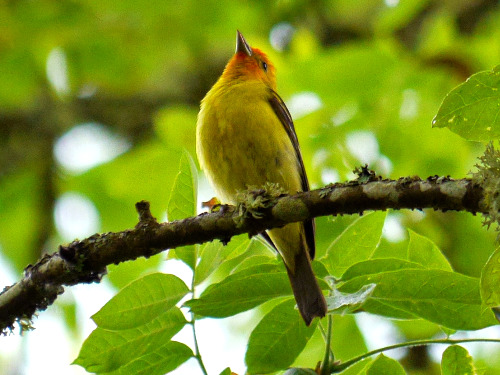 Male Western Tanager in an Oregon Ash tree. Photo by Ollie Oliver |
|
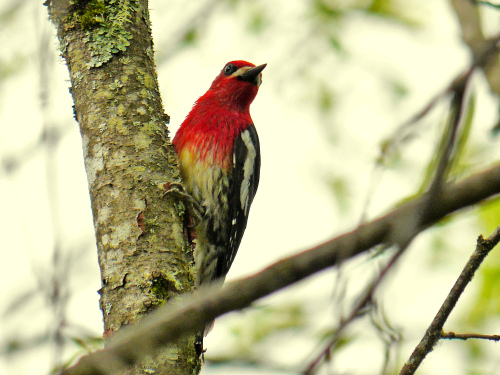 Red-breasted Sapsucker. Photo by Ollie Oliver |
|
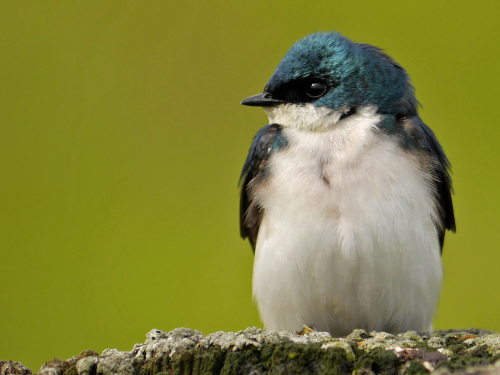 Tree Swallow. Photo by Ollie Oliver |
|
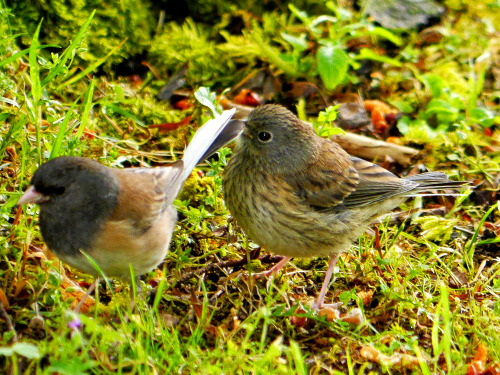 Adult (left) and juvenile Dark-eyed Junco. Photo by Ollie Oliver |
|
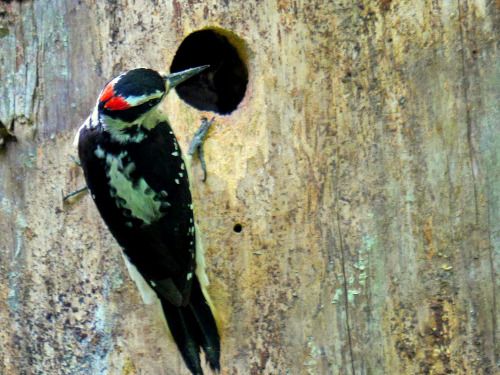 Male Hairy Woodpecker at the nest hole. Photo by Ollie Oliver |
|
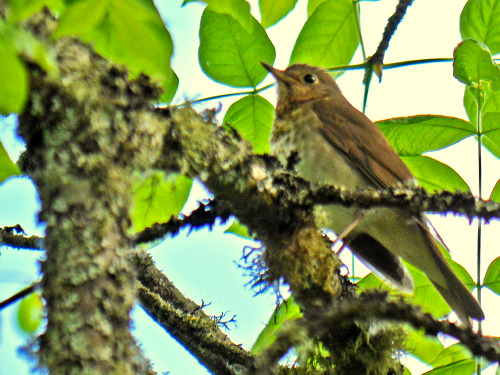 Swainson's Thrush in an Oregon Ash tree at the Rowing Club. Photo by Ollie Oliver |
|
|
|
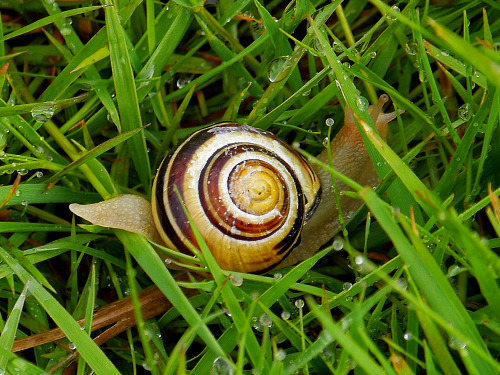 Snail. Photo by Ollie Oliver |
Report for May 24, 2012 Birding at Marymoor
|
Maybe the night's rain, the dark clouds, and the weather forecasts scared people away today. There were just 7 of us today, and we enjoyed a very fine day of birding. There were clouds and occasional mist, with moments of drizzle, but quite a bit of sunshine as well. And it was birdy (as well as rather mosquitoey) |
|
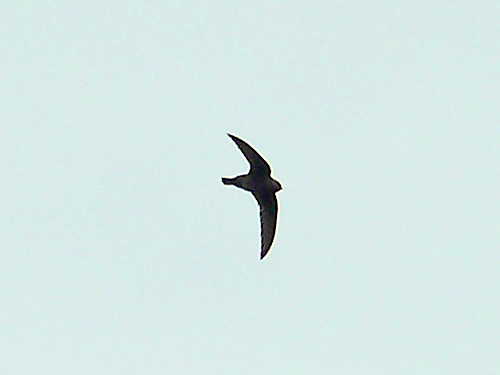 Black Swift. Photo by Ollie Oliver |
 Black Swift. Photo by Ollie Oliver |
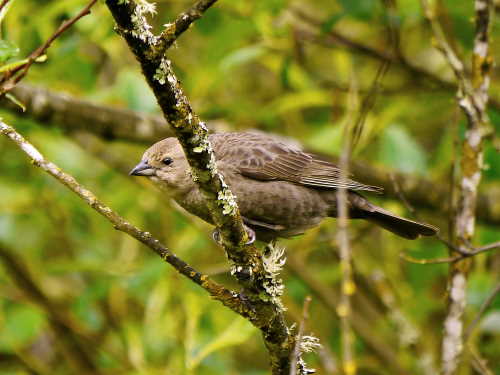 Female Brown-headed Cowbird. Photo by Ollie Oliver |
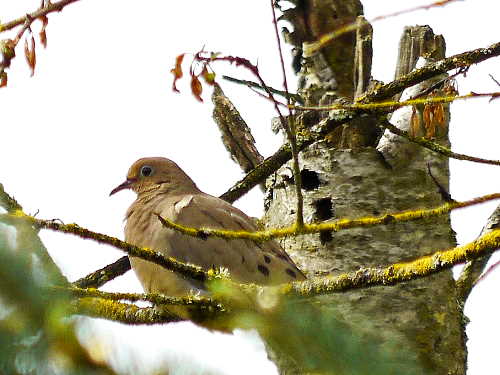 Mourning Dove in Snag Row. Photo by Ollie Oliver |
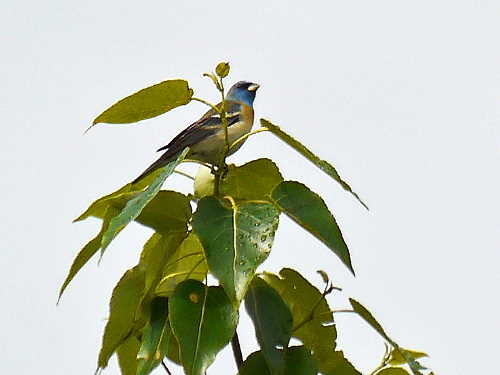 One of two male Lazuli Buntings in Snag Row. Photo by Ollie Oliver |
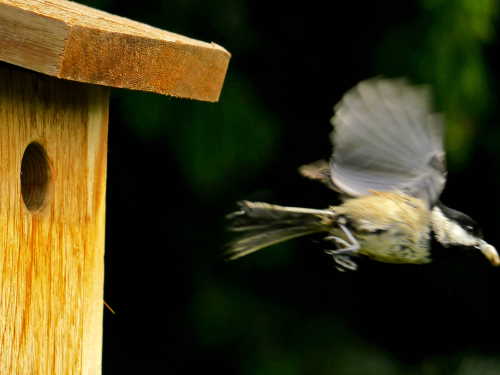 Black-capped Chickadee removing a fecal sac from one of the new nest boxes in the Community Gardens. There were noisy young in the box. Photo by Ollie Oliver |
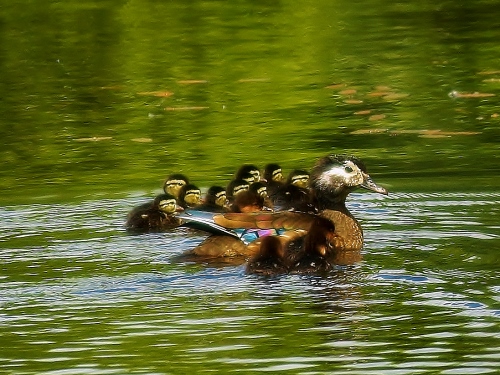 Wood Duck with ducklings. The darker ducklings with the orange cheeks are Hooded Merganser ducklings, presumably hatched from eggs dumped by a Hoodie in the Wood Duck's nest box or hole.. Photo by Lillian Reis |
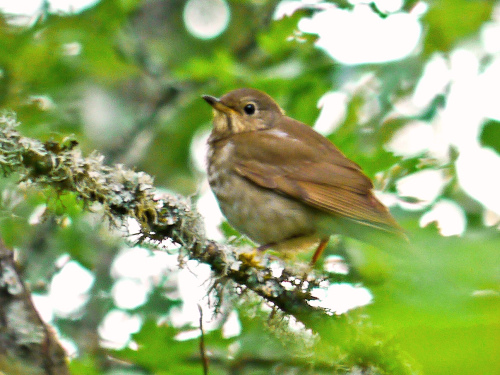 Swainson's Thrush. Photo by Ollie Oliver |
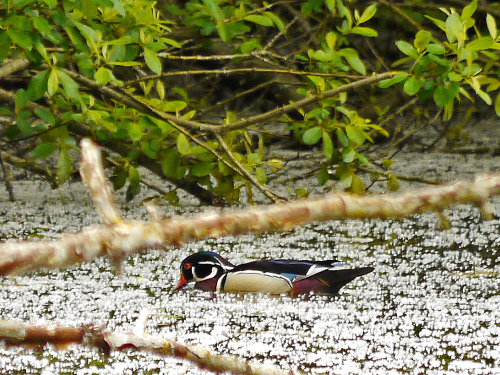 Male Wood Duck, 2012-05-23. Photo by Ollie Oliver |
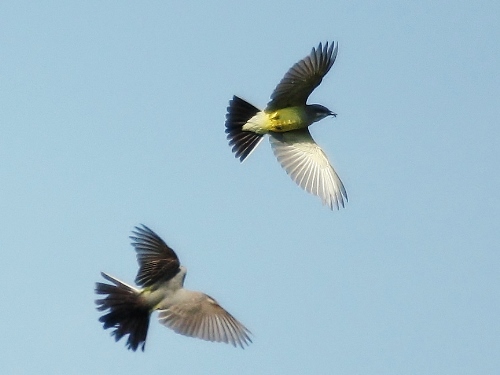 Western Kingbirds, 2012-05-19. Photo by Lillian Reis |
Report for May 26, 2011 Birding at Marymoor
|
It was cold, dark, and breezy this morning, though gradually the clouds cleared as the wind picked up. Did I mention cold? Water levels are still high too, so it didn't feel very spring-like to say the least. It was fairly birdy, though it was a day when we didn't get a whole lot of great long looks at birds. Sometimes we had long looks and sometimes we had great looks, but rarely both. With the leaves fully out, we spent a lot of time peering into trees at birds flitting about, revealing little about themselves. So I believe that brings the park year list up to 135 (unofficial :) ) |
|
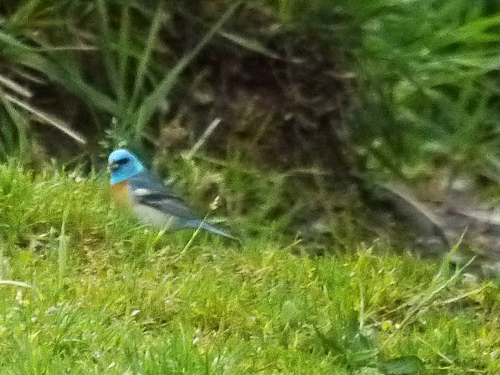 Male Lazuli Bunting. Photo by Ollie Oliver |
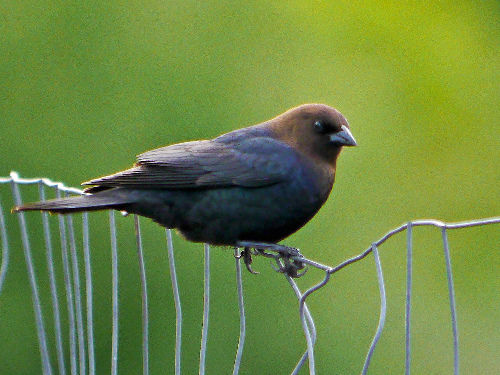 Male Brown-headed Cowbird. Photo by Ollie Oliver |
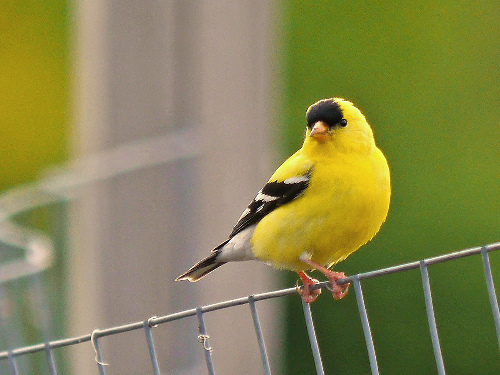 Male American Goldfinch. Photo by Ollie Oliver |
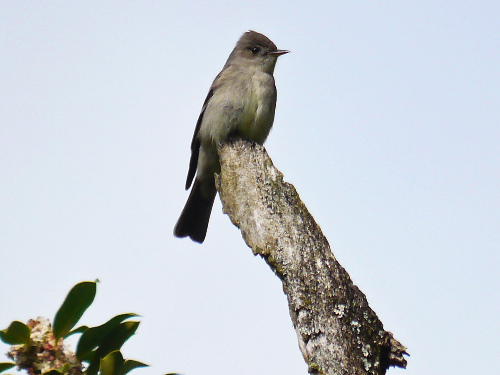 Western Wood-Pewee. Photo by Ollie Oliver |
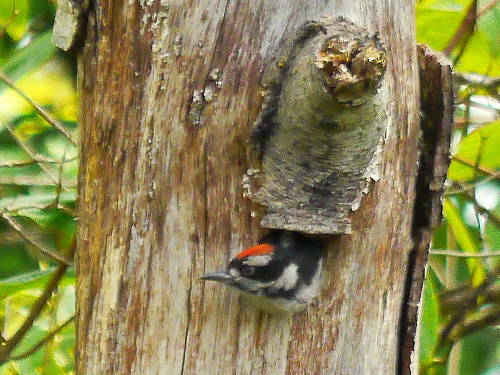 Juvenile Hairy Woodpecker. Note the red on the top of the head. Photo by Ollie Oliver |
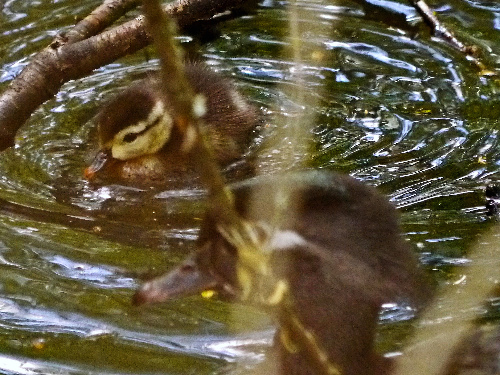 Wood Ducks at the Rowing Club. Photo by Ollie Oliver |
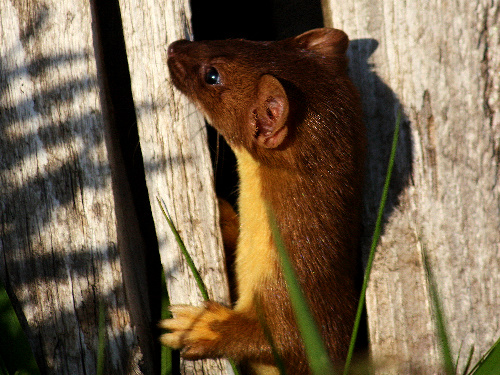 Long-tailed Weasel, 2011-05-24. Photo by Lillian Reis |
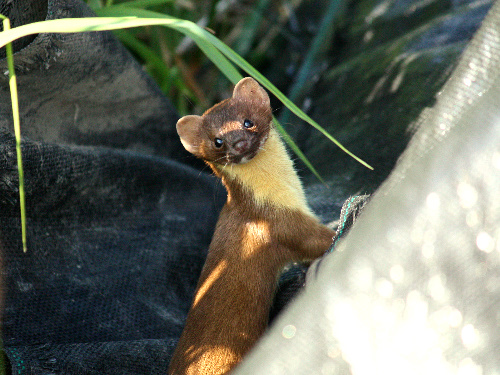 Long-tailed Weasel, 2011-05-24. Photo by Lillian Reis |
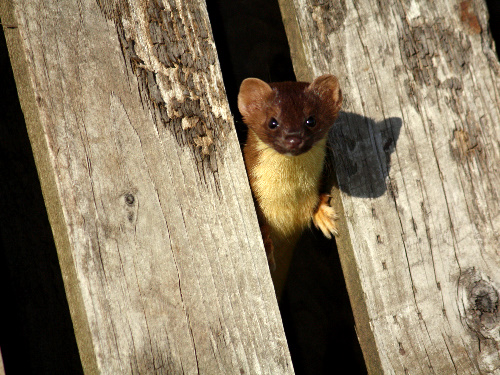 Long-tailed Weasel, 2011-05-24. Photo by Lillian Reis |
 Male Hairy Woodpecker at the nest, with baby in hole, 2011-05-23. Photo by Marc Hoffman |
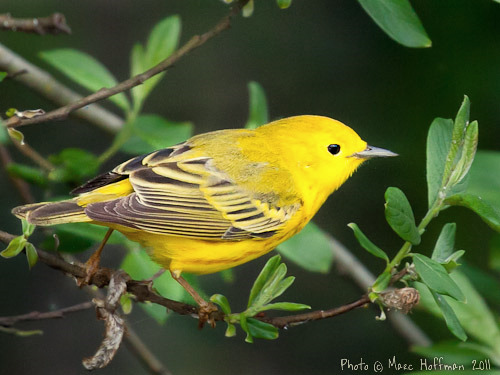 Male Yellow Warbler, 2011-05-23. Photo by Marc Hoffman |
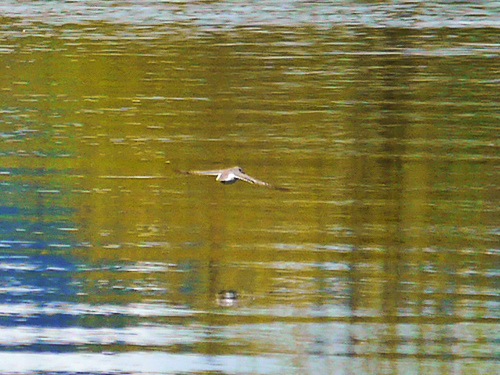 Spotted Sandpiper, 2011-05-22. Photo by Ollie Oliver |
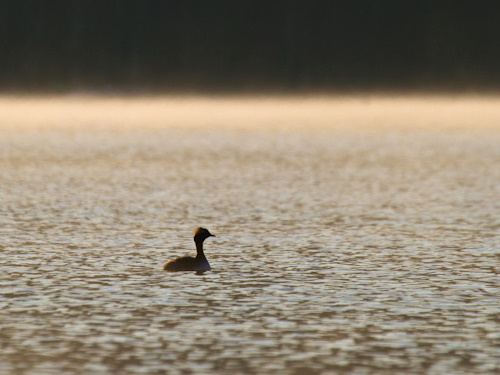 Late April Horned Grebe, 2011-04-23. Photo by Tony Ernst |
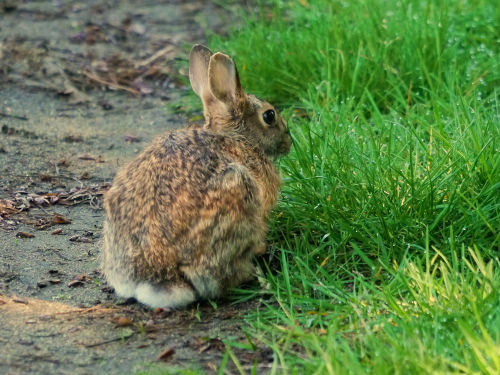 Eastern Cottontail, 2011-05-19. Photo by Ollie Oliver |
Report for May 27, 2010
|
The weather was actually decent this morning. Well, not windy, not too cold, no precipitation. It was overcast, especially early on, and we were beset with thick fog for the first couple of hours. But really, compared to - say - yesterday, it was a delight. There were LOTS of birders, and luckily there were also LOTS of birds to look at and listen to., There were quite a few things that were seen/heard by only a few people, but that's the way it goes when you approach 20 people in the group. |
|
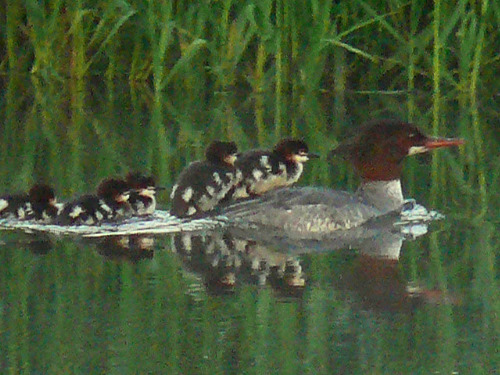 Closer view of the babies climbing up. Photo by Ollie Oliver |
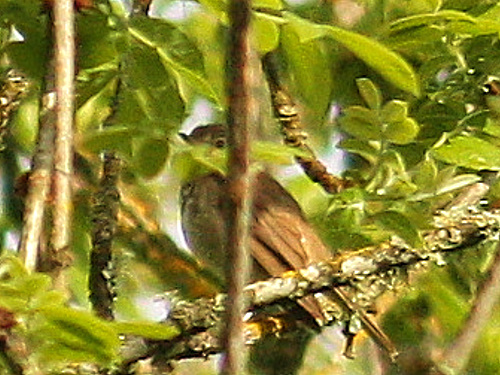 Swainson's Thrush photo by Lillian Reis |
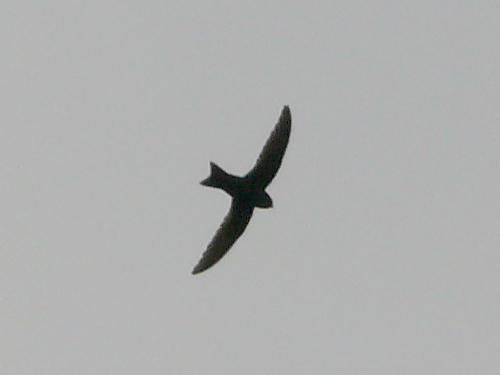 Black Swift. The tail can look deeply notched... |
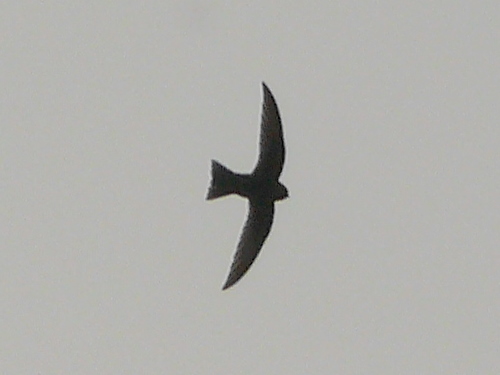 ...or slightly indented. The wings are usually arced, as here |
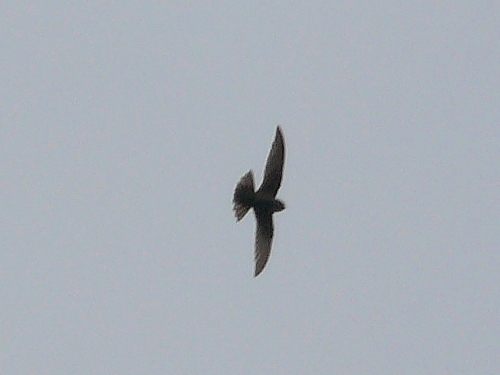 Perhaps this Black Swift was maneuvering for a bug - tail flared, wings thrust forward |
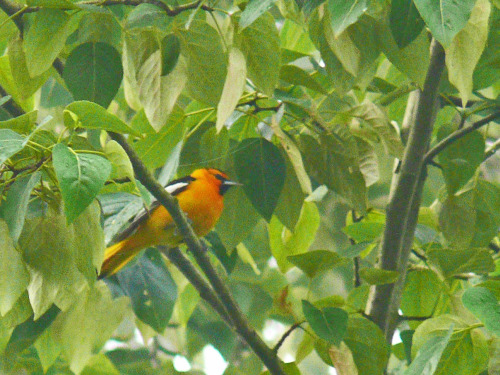 Male Bullock's Oriole. Photo by Ollie Oliver through the fog |
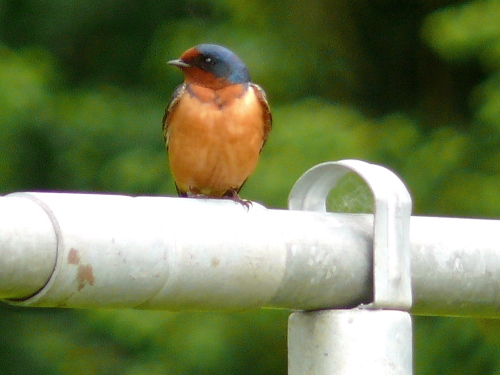 Barn Swallow on the Stage fencing |
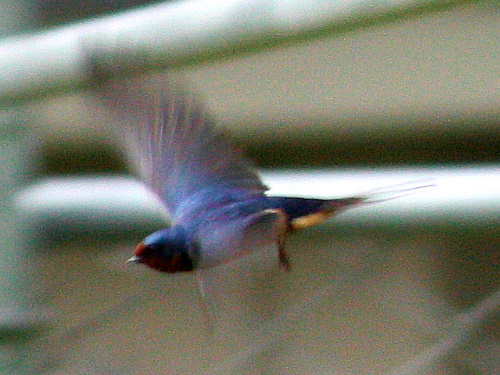 ...and leaving the fence. Photo by Lillian Reis |
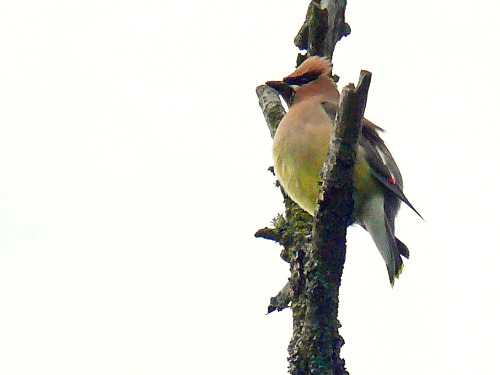 Cedar Waxwing. Photo by Ollie Oliver |
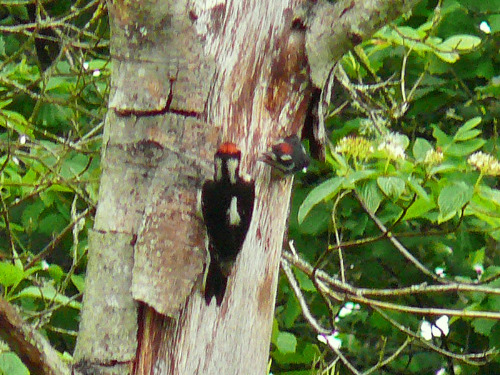 Male Hairy Woodpecker bringing food to the young. Photo by Ollie Oliver |
 Female arriving at the nest. Photo by Ollie Oliver |
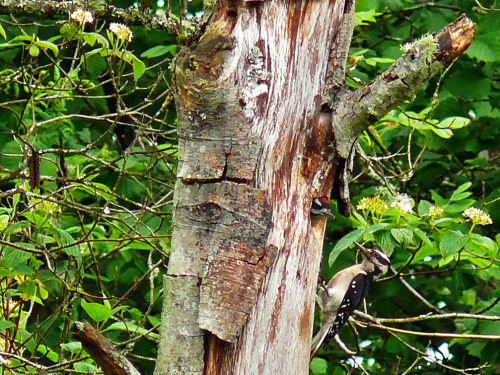 Female with young. Photo by Ollie Oliver |
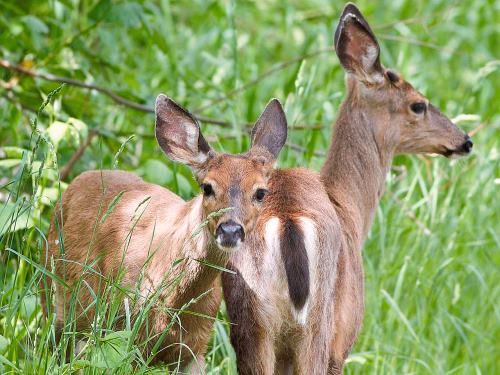 Mule Deer. Photo by Megan Lyden, 2010-05-21 |
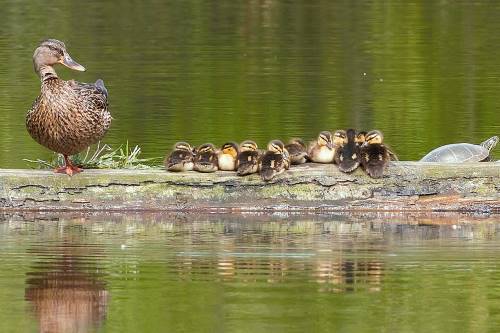 Female Mallard, with her ducklings and a turtle. Photo by Megan Lyden, 2010-05-21 at the Rowing Club |
Report for May 21, 2009
|
It was a perfect day, weatherwise. Sunny, warm (but not hot), pretty much windless. The birds were singing and active, and there were a lot of them. Good diversity too, plus LOTS of new things for the year. Highlights: Green Heron On the nest at the Rowing Club The BLACK SWIFTS seemed to be making sure they stayed above the PEREGRINE FALCON. The falcon, BTW, appeared to be a sub-adult, as did the Cooper's Hawk. TEN NEW BIRDS FOR THE YEAR: Spotted Sandpiper, Mourning Dove (though I think someone reported one previously), Black Swift, Olive-sided Flycatcher, Western Wood-Pewee, Willow Flycatcher, Cassin's Vireo, Lazuli Bunting, Bullock's Oriole, and Evening Grosbeak So for the day, 68 species. For the year, we're up to 140 species. == Michael |
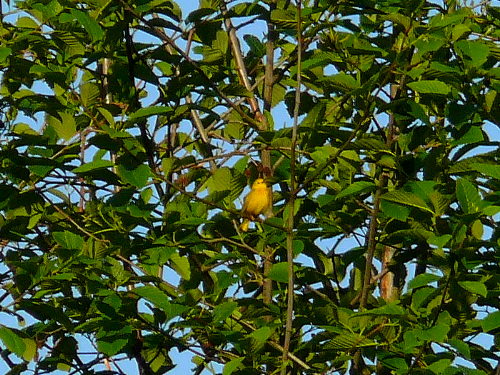 Male Yellow Warbler singing from the far side of the slough 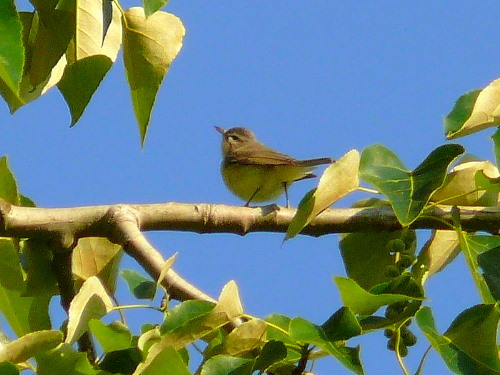 One of the hoards of Warbling Vireos |
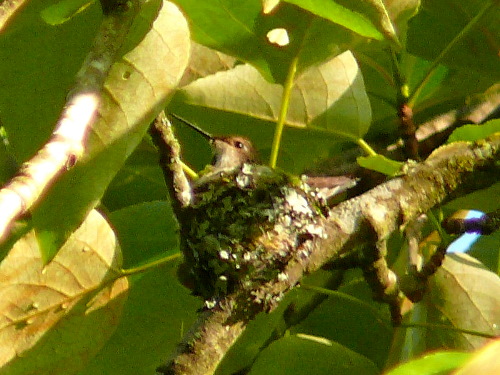 Female Rufous Hummingbird on her nest near Dog Central |
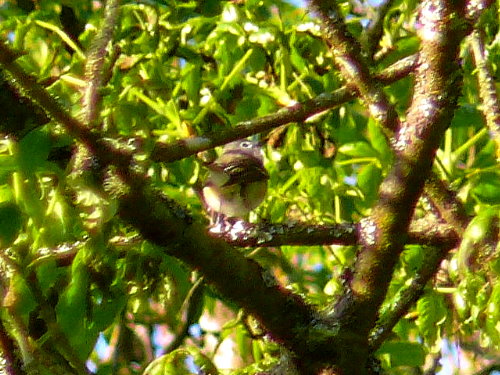 Cassin's Vireo |
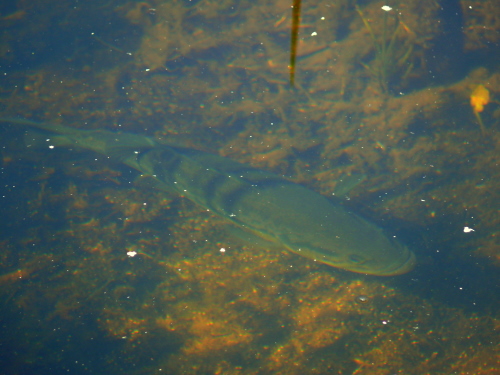 Large Bass seen from the lake platform |
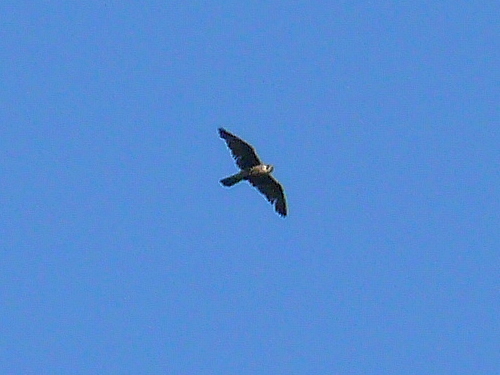 Peregrine Falcon high over the boardwalk |
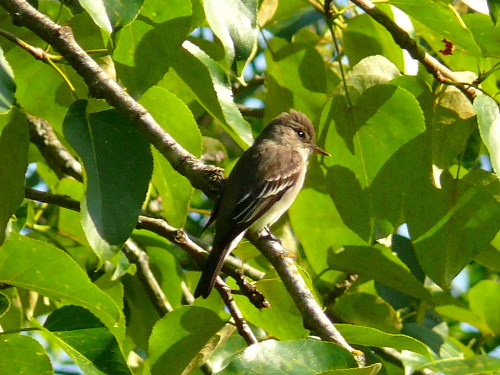 Willow Flycatcher |
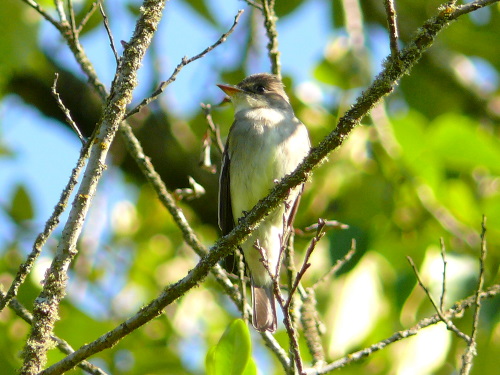 Same Willow Flycatcher |
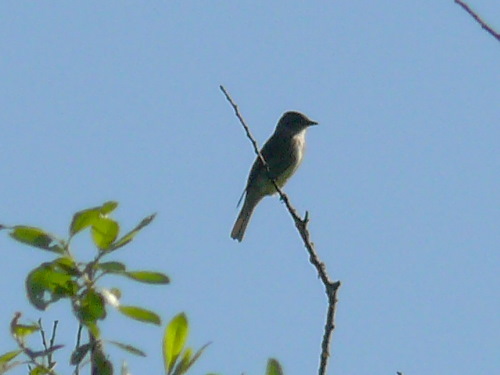 Olive-sided Flycatcher - we had two disparate sightings |
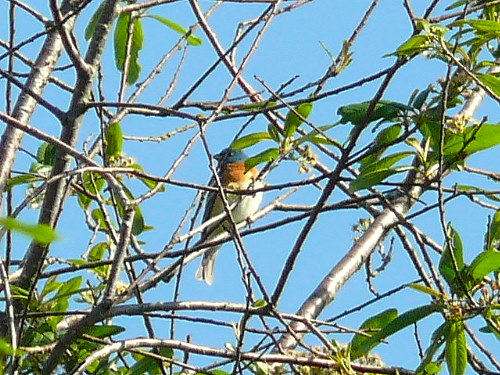 Male Lazuli Bunting in the cherries at the Compost Piles |
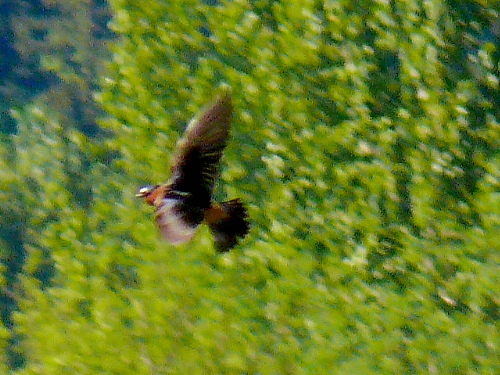 Cliff Swallow - note light forehead and buffy rump |
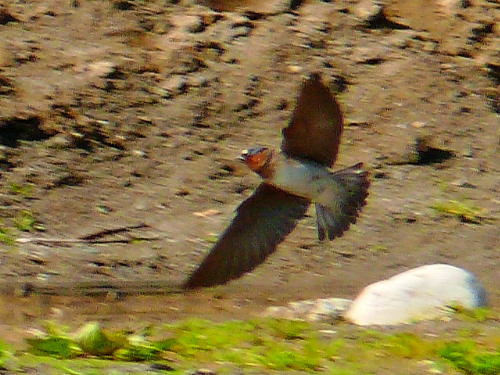 Cliff Swallow |
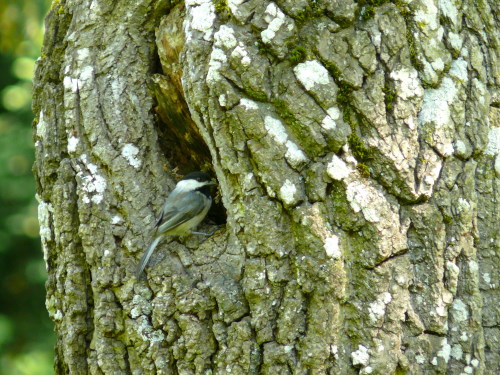 Black-capped Chickadees appear to be nesting SE of the stage |
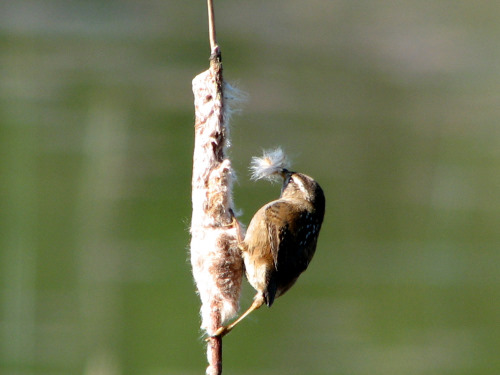 Scott Ramos's photo of a Marsh Wren gathering nest materials |
Report for May 22, 2008
| There were only about 8 of us this morning under unrelenting gray, misty skies. There was mist, mizzle, and drizzle throughout the morning, and it was chilly, though thankfully there was no wind. The birds were somewhat scarce, but there were things to look at: Mallard Female(s?) with small 'lings Bald Eagle On "new" nest, more over lake Green Heron 2 flying together down slough Mourning Dove 2 over East Meadow Red-breasted Sapsucker 3+ sightings - looking great Willow Flycatcher They're BACK - maybe 3 seen Warbling Vireo Not many seen, but constant song Purple Martins Pair at west gourd Tree Swallow Still trying to claim east gourd Swainson's Thrush Back as well, though no singing yet American Robin Begging young Western Tanager One group moving through Black-headed Grosbeak Abundant LAZULI BUNTING Singing near east kiosk Twice we saw two SONG SPARROWS strutting around together, all puffed up. There was wing fluttering, suggesting copulation solicitation, but no copulation was observed. They looked like tiny red-brown grouse. It was very funny. Lesser Song-Grouse on the lek? For the day, 61 species. For the year, 127 species. == Michael |
|
|
|
|
|
|
Female Mallard with ducklings. Photo by Ollie Oliver. |
Report for May 24, 2007
| The day was probably a bit too nice. Needed only a couple of sweaters this morning, and after the fog burned off, it was sunny and warm. We heard a lot, but had trouble finding views of birds; perhaps many of them are so busy with their lives that they just don't have time to perch in the open. Plus, too many leaves and too many mosquitoes.
Highlights: BUFFLEHEAD Lingering female, seen late on the lake Juveniles (mostly seen being fed by parents): For the day,64 species. Red-eyed Vireo was the only new one for the 2007 list. == Michael |
|
|
|
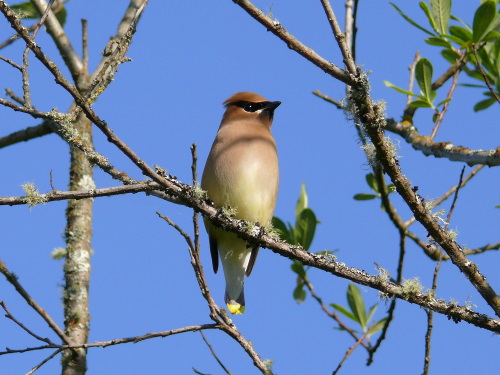 Cedar Waxwing |
Prev |
Bird Sightings Week 21
|
Next |
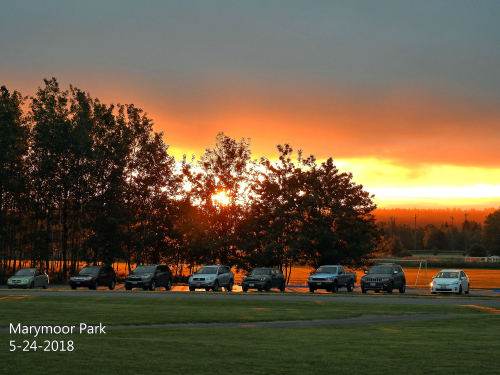
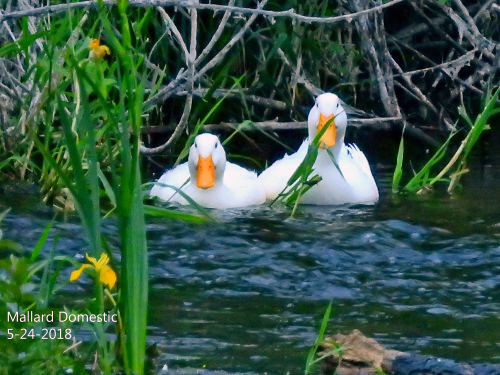
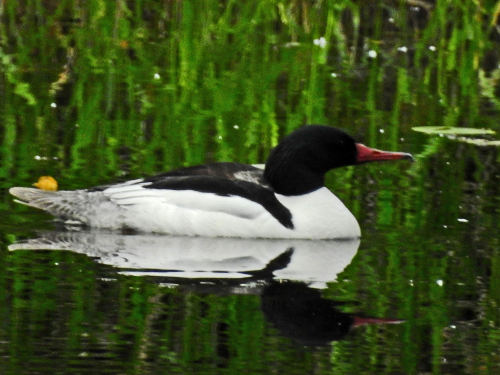
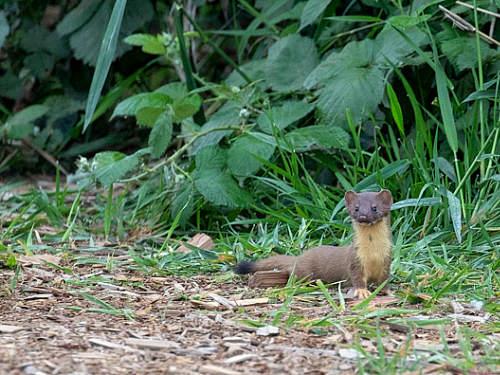
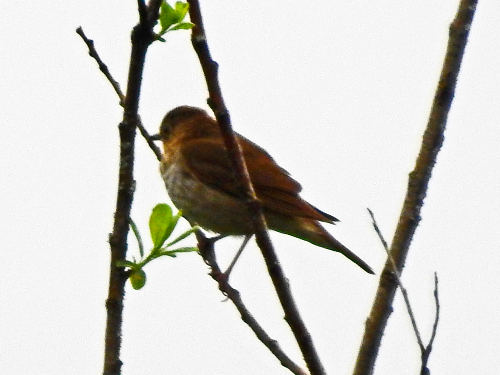
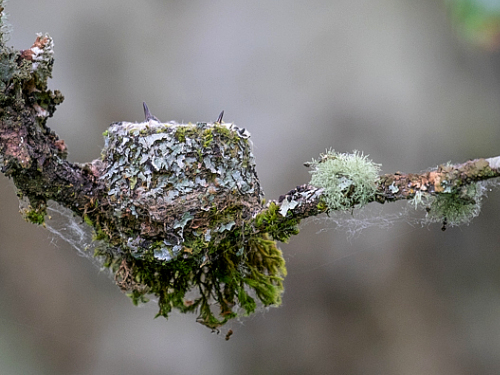

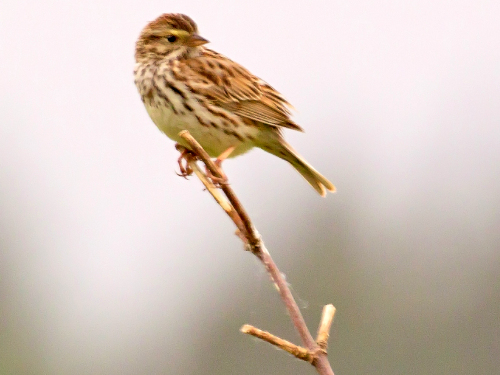
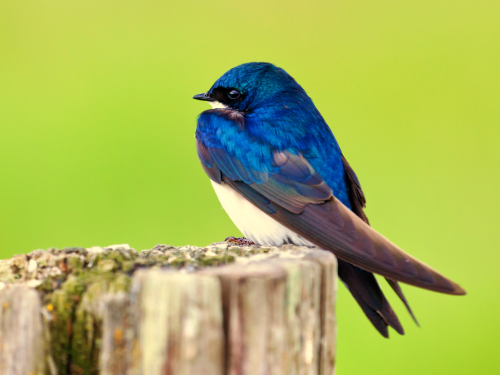

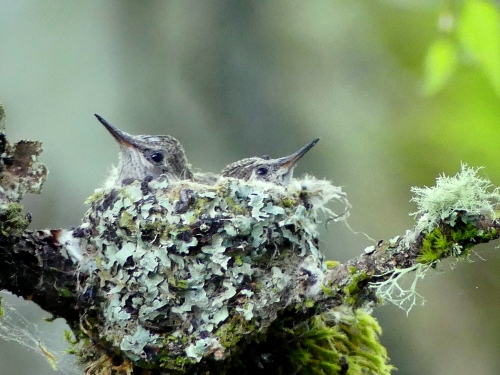
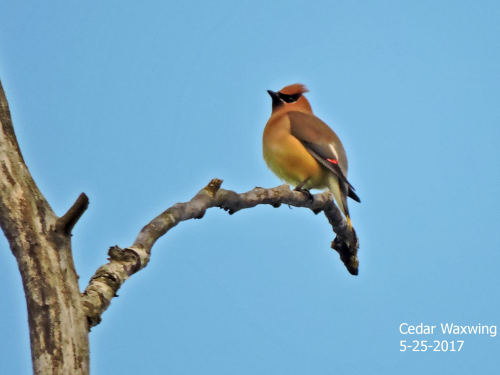

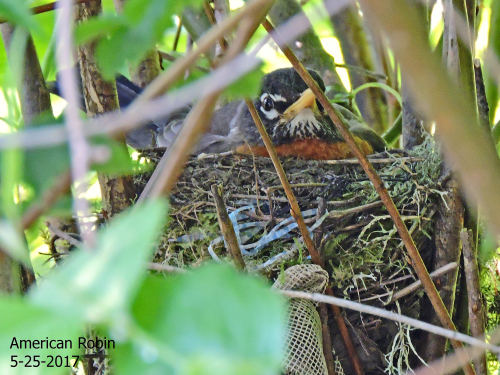

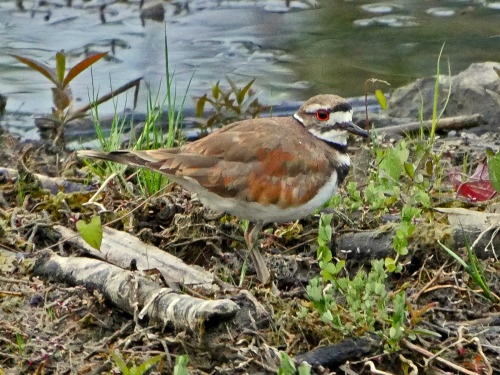
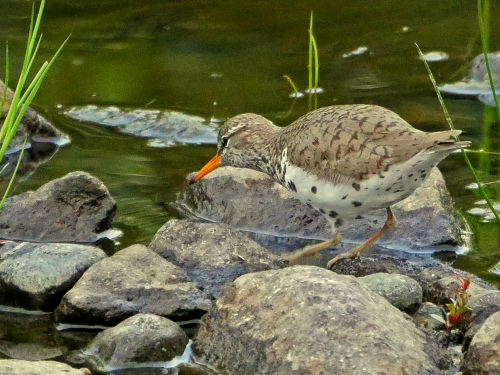
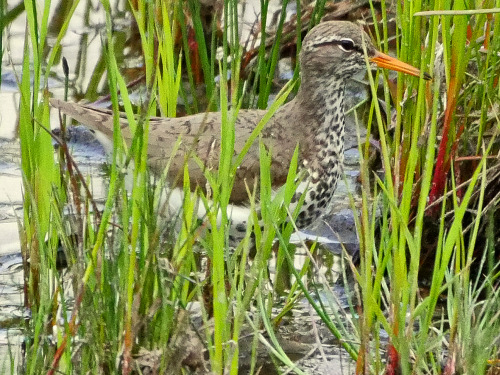
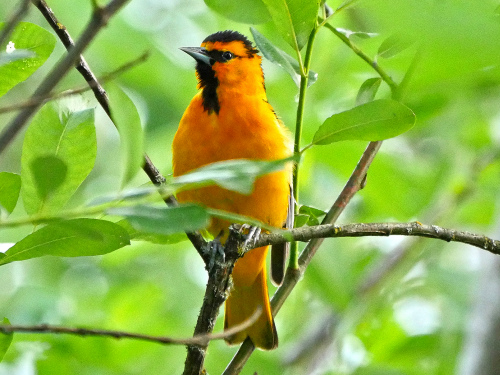
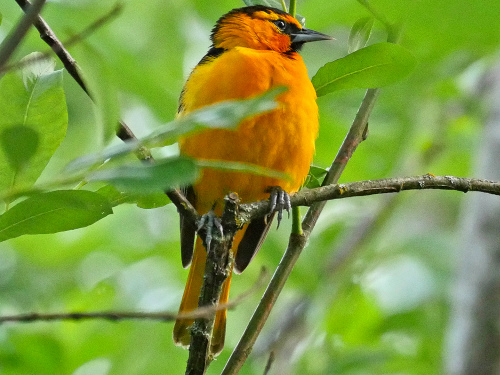
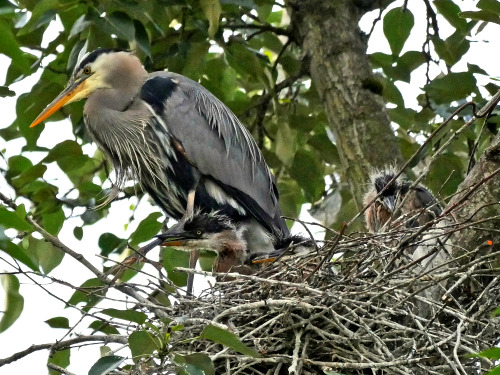
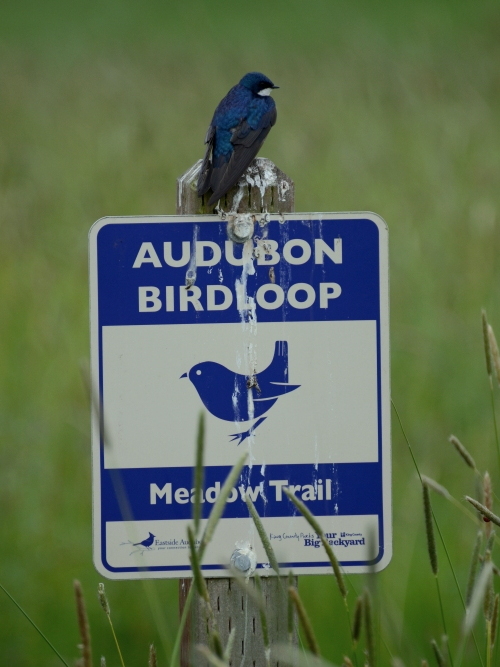
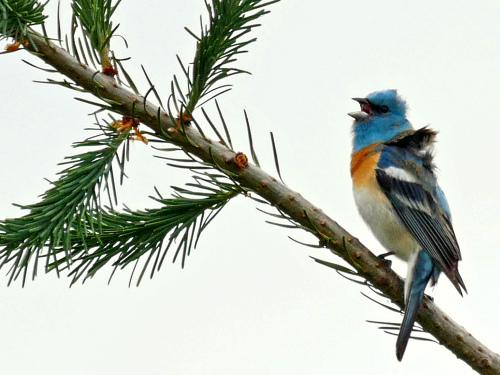
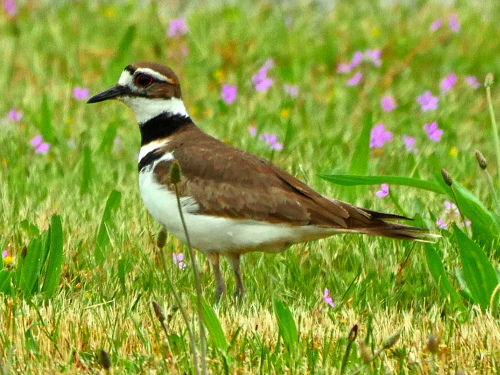
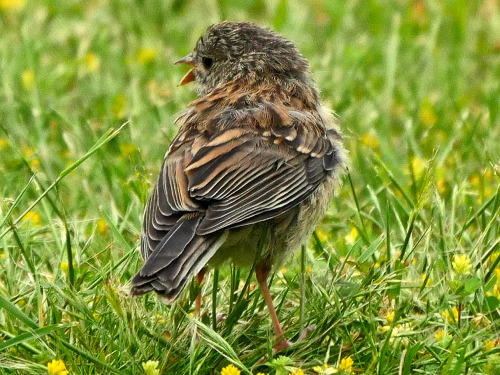
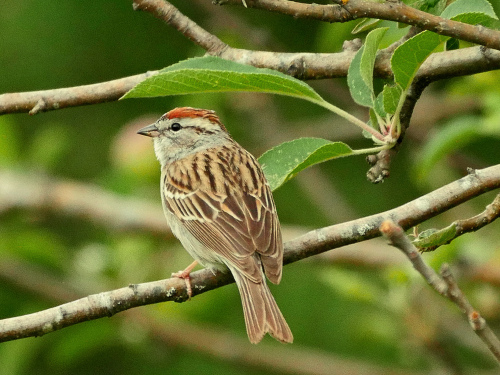

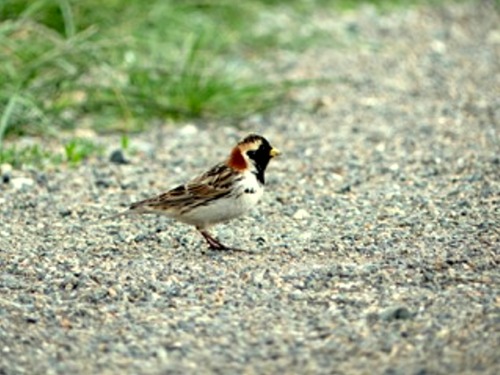

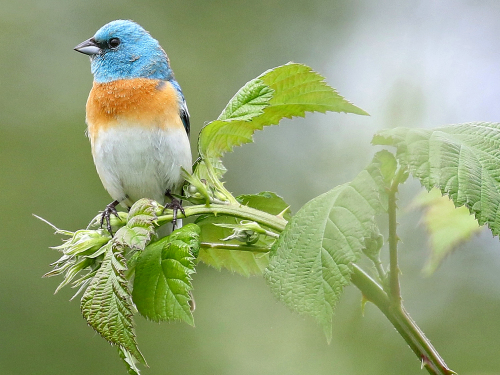

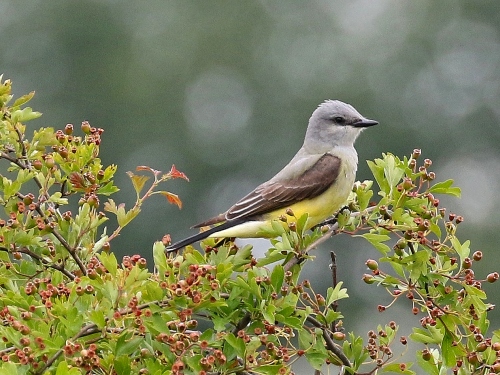
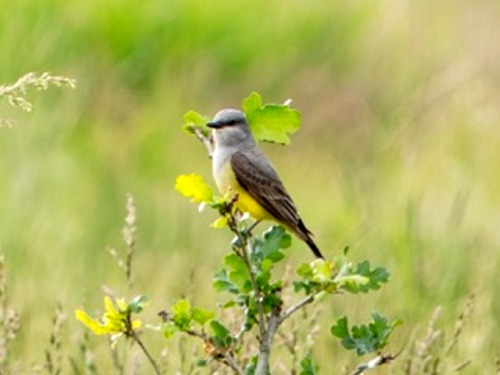
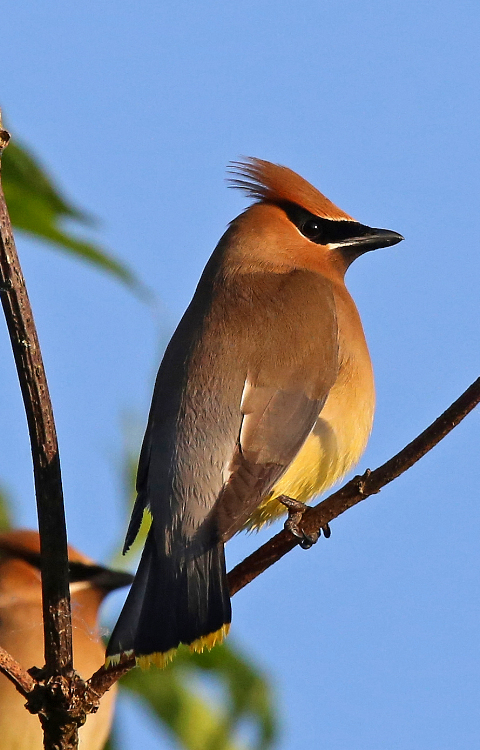

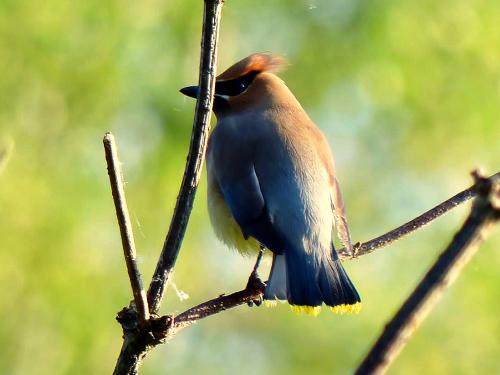
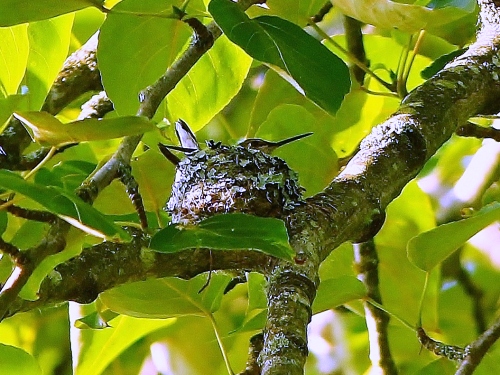
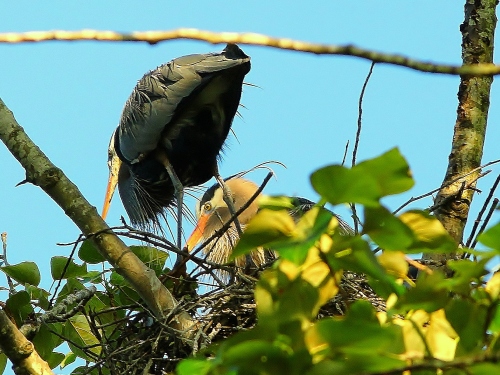 P
P